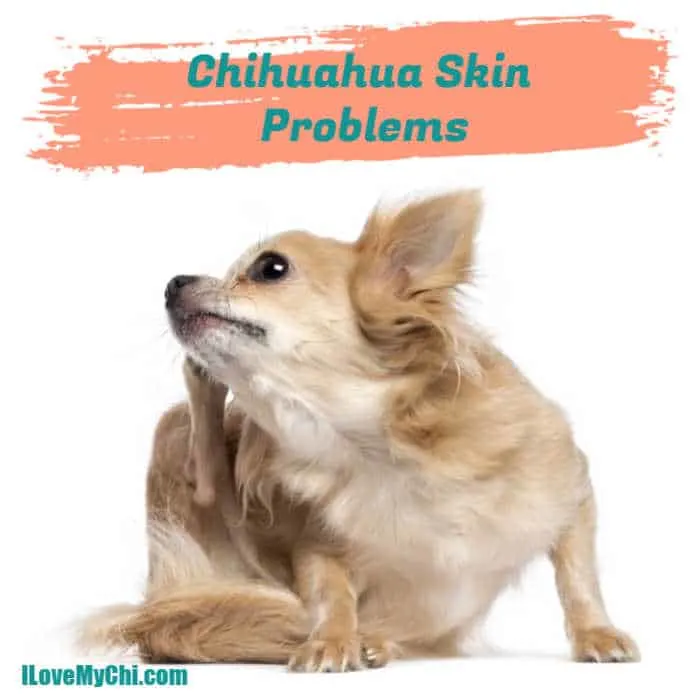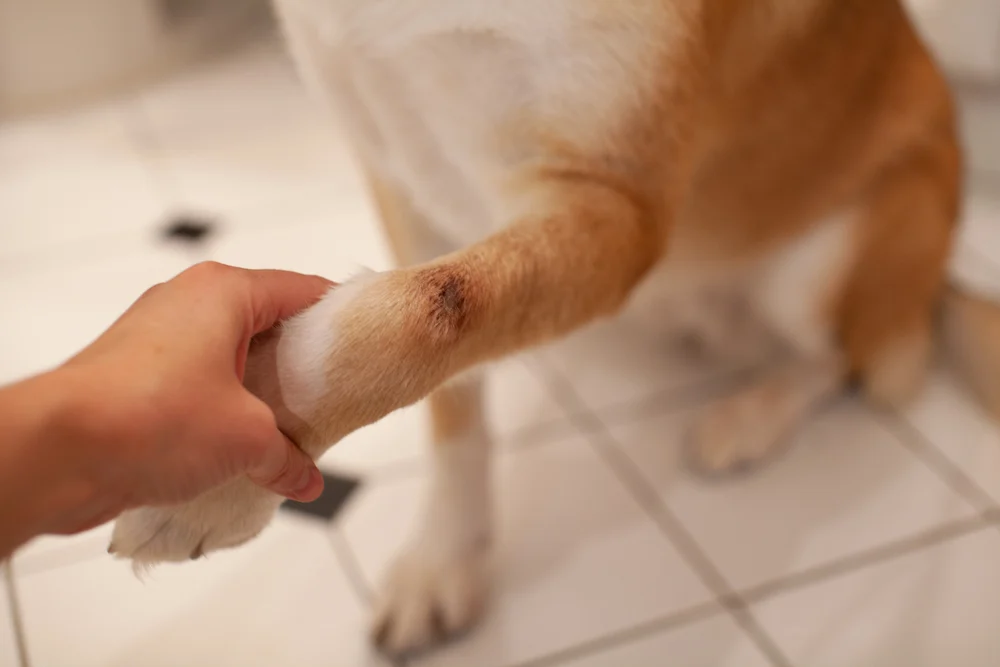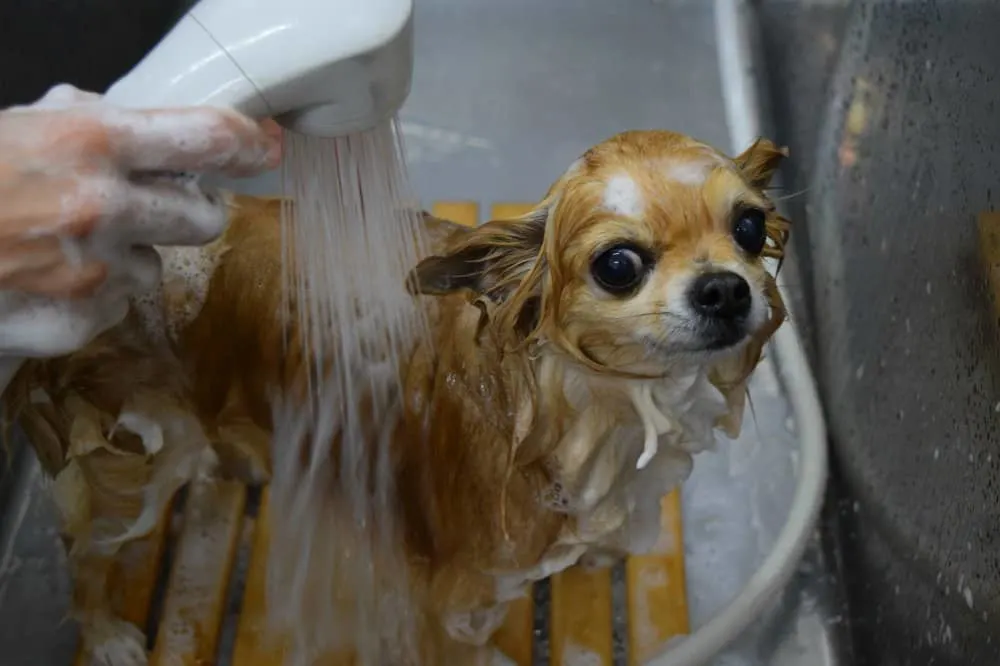Hey, Chi lovers! Nothing breaks our hearts like seeing our tiny Chihuahuas scratching or looking uncomfortable in their own skin. Skin problems like allergies, mange, or hot spots can make your pup miserable, and with over 160 possible skin issues in dogs, it’s no small matter!
Based on 2025 veterinary guidelines from PetMD and the American Heartworm Society, here’s your guide to spotting, preventing, and treating common Chihuahua skin problems—plus some myths to bust and FAQs to answer. Let’s get those tails wagging again!

Why Chihuahuas Get Skin Problems
Chihuahuas’ small size and sensitive skin make them prone to issues like allergies, mange, yeast infections, and hot spots. These can stem from fleas, diet, genetics, or environmental triggers like pollen.
In rare cases, skin issues may signal systemic problems like heartworm disease, which affects over 1 million dogs in the U.S. annually, per the AHS. The good news? With the right care, you can keep your Chi’s skin healthy and shiny.
Common Chihuahua Skin Problems
Here are the top skin issues your Chihuahua might face, per recent veterinary insights:
- Allergies: Flea bites, food (e.g., chicken, grains), or environmental triggers (pollen, mold) cause intense itching, red skin, or paw licking. Chihuahuas are especially prone to atopy (a genetic predisposition to developing allergic reactions, particularly those mediated by IgE antibodies, in response to environmental allergens), with symptoms peaking at ages 1–3.
- Mange: Caused by Demodex (non-contagious) or Sarcoptes (scabies, contagious to humans) mites, mange leads to hair loss, redness, and crusty sores. A vet’s skin scraping will confirm which one it is.
- Hot Spots: Red, oozing areas from scratching or licking, often triggered by fleas or allergies. They spread fast and need vet care.
- Yeast Infections: Common in paws or ears, these cause a musty odor, redness, and itching. Look for brown discharge in the ears.
- Color Dilution Alopecia (CDA): Blue or lilac Chihuahuas may lose hair due to a recessive gene, leading to thin coats and skin irritation.
- Sunburn/Skin Cancer: White-coated Chihuahuas are at risk due to low pigmentation. Watch for red or crusty skin after sun exposure.
Pro Tip: If your Chi’s scratching persists over 24 hours or you see hot spots, hair loss, or odor, call your vet.
How to Spot Skin Problems
Look for these signs, especially on your Chi’s belly, ears, or paws:
- Itchy, red, or scabby skin
- Hair loss or thinning (especially in blue Chihuahuas)
- Musty odor or brown ear discharge
- Hot spots (moist, red patches)
- Lethargy or paw licking
- Swelling or hives (possible allergic reaction)
If symptoms linger or include severe signs like facial swelling, get to the vet ASAP. Persistent issues might need tests (e.g., skin scrapings, blood work) to rule out infections or heartworm-related complications.
Preventing Skin Problems
An ounce of prevention is worth a pound of cure! Try these vet-approved tips:
- Feed a Skin-Friendly Diet: Switch to organic, grain-free foods with novel proteins (e.g., fish, venison) like Hill’s z/d or Royal Canin Veterinary Diet. Or make your own dog food where you know exactly what is in it. Get your vet’s approval for whatever recipe you choose or ask them for a recipe. Add salmon oil (100 mg per 10 lbs daily) for omega-3s, but check with your vet.
- Use Vet-Approved Parasite Control: Chihuahuas are sensitive, so use prescription flea/tick/heartworm preventatives.
- Groom Smart: Brush weekly or even daily with a soft brush to spread natural oils. Bathe monthly with oatmeal-based shampoos (e.g., Relief Shampoo) to avoid stripping oils.
- Protect from the Sun: Apply dog-safe sunscreen to white-coated Chihuahuas during outdoor time.
- Control Environment: Remove standing water and use pet-safe larvicides (e.g., Mosquito Dunks) to reduce fleas and mosquitoes.
Pro Tip: Check local heartworm risk at heartwormsociety.org and schedule annual testing to catch issues early.
Treating Chihuahua Skin Problems
Most mild issues improve with care, but severe cases need a vet. Here’s how to help:
- Clean the Area: Wash hot spots or itchy skin with mild soap and water. Pat dry gently.
- Soothe with Home Remedies: Apply pet-safe coconut oil (1/4 tsp per 10 lbs daily, topical or in food) or oatmeal sprays for mild itching, but get vet approval.
- Prevent Scratching: Use a cone or dog shirt to stop licking, which worsens infections.
- Medications: Vets may prescribe:
- Antihistamines (Benadryl, 1 mg/lb twice daily) for mild allergies
- Apoquel or Cytopoint for chronic itching
- Antibiotics for hot spots or infections
- Medicated shampoos for mange or yeast
- Severe Cases: Autoimmune issues or CDA may need steroids or a veterinary dermatologist. Skin cancer requires biopsy and possibly surgery.
- Heartworm Check: If lethargy accompanies skin issues, test for heartworm, as it affects over 1 million dogs yearly and can cause systemic symptoms.
Pro Tip: Keep a pet first-aid kit with antiseptic wipes and a cone for quick relief.
Myths vs. Facts
- Myth: All scratching is normal. Fact: Persistent itching may mean allergies or parasites.
- Myth: Over-the-counter flea products are safe. Fact: Chihuahuas need vet-prescribed treatments like Revolution.
- Myth: Bathing fixes all skin issues. Fact: Over-bathing worsens dryness. Stick to monthly baths.
FAQs About Chihuahua Skin Problems
Q: Can diet cause my Chi’s skin issues?
A: Yes, allergies to some grains or proteins like chicken are common. Try grain-free foods with fish or venison, per vet advice.
Q: Are blue Chihuahuas more prone to skin issues?
A: Yes, Color Dilution Alopecia can cause hair loss and irritation in blue or lilac Chihuahuas.
Q: When should I see a vet?
A: If itching, hot spots, or hair loss lasts over 24 hours with no signs of improvement, or if you see swelling or odor, get veterinary care.
Affordable Care Tips
Vet bills can be tough, as some of you shared on our Facebook page. Check local SPCAs or veterinary colleges for low-cost care, or try telemedicine for initial advice. Your Chi deserves the best, even on a budget.
Your Chi’s Skin Care Plan
Keep your Chihuahua’s skin healthy with a great diet, regular grooming, and vet-approved preventatives. Share your skin care tips in the comments below or on our Facebook page—I’d love to hear what works for your pup! For more info, visit heartwormsociety.org or avma.org. Let’s keep those Chihuahuas comfy and itch-free!


Cathy Bendzunas
Pet Blogger

Dr. Sara Ochoa
DVM
This article has been fact-checked and approved by Dr. Sara Ochoa DVM. You can read more about her on our About page.





Mary Jones and Ginger
Friday 23rd of May 2025
All good information and advice! My chi (short hair fawn colored deer head) presented with environmental allergies with excessive licking. She gets a cytopoint every few months now and the allergies are completely resolved. It’s weight based and she’s a larger lady at 9 # so the cost is based on weight. Amazing medication. It’s a bit pricy but so worth it! Definitely have your chi seen by the vet so they don’t suffer!
Cathy Bendzunas
Saturday 24th of May 2025
My Yorkie gets Cytapoint shots too. Nothing else works for him. My Chihuahua has a few food allergies and getting her off chicken helps her.
Gina
Monday 3rd of March 2025
The article about herbs for dogs is really interesting. I would like to see more in-depth information on how to properly use them.
Also, is there a website with all the articles you have provided over the years?
Thank you for creating the newsletters.
Cathy Bendzunas
Monday 3rd of March 2025
If you look at the top of the page on my site, you will see the categories. Click on any of them that interest you and you will see a list of articles.
Diane
Friday 26th of October 2018
Baby Alex
Cathy
Friday 26th of October 2018
Baby Alex is a total cutie Diane!
Kyle
Tuesday 7th of August 2018
my chica is scratching like crazy and rubbing on the carpet. She is mostly scratching her back at the bottom of her tail. Her skin is red and irritated. Any home remadeis, cant aford vet.
Gina
Monday 3rd of March 2025
@Kyle, I am not a vet, so you might want to verify this with your vet: I have heard dogs can develop allergies to chicken. If your dog’s food has chicken, you might want to change over to food without poultry in it to see if that helps.
Cathy
Tuesday 7th of August 2018
It's prime flea season now so there's a good chance it's fleas. We have a page with some home remedies for getting rid of fleas here: https://ilovemychi.com/best-natural-flea-treatments-for-dogs/
Liz
Thursday 1st of March 2018
My Lucy has been miserable as I am . She is constantly chewing and has these dark spots and flaking on her lower belly and private area . I’ve tried dawn soap and diluted vinegar rinses, ever put vinegar in her water as I’ve read it helps control fleas but it doesn’t. As soon as I get the money I’m taking her to the vet because my poor baby girl is miserable
Anonymous
Tuesday 17th of April 2018
It’s not flea allergy. It’s food allergy
Kathleen
Monday 16th of April 2018
Hi Liz, your chi’s belly looks very familiar. My chi gets more of them on her back. Vet seen it and nothing. One day I gave her my other dogs food that’s for dog with food allergies. Her skin started to get way better. Her hair even started to grow back. Hill's Prescription Diet z/d in can. Your vet can give you a Rx or sometime they sale it.
I also give my dog Halo vegan formula. Only try Halo vegan after your dog’s system has been detox with the Hill’s z/d food.
I hope this helps you and other.
Cathy
Friday 2nd of March 2018
Poor baby! She may have developed a skin infection due to a flea allergy. She does need to see a vet as soon as possible. We have an article that may give you some ideas on how to be able to get her to the vet quicker: https://ilovemychi.com/what-to-do-when-you-cant-afford-vet-care/